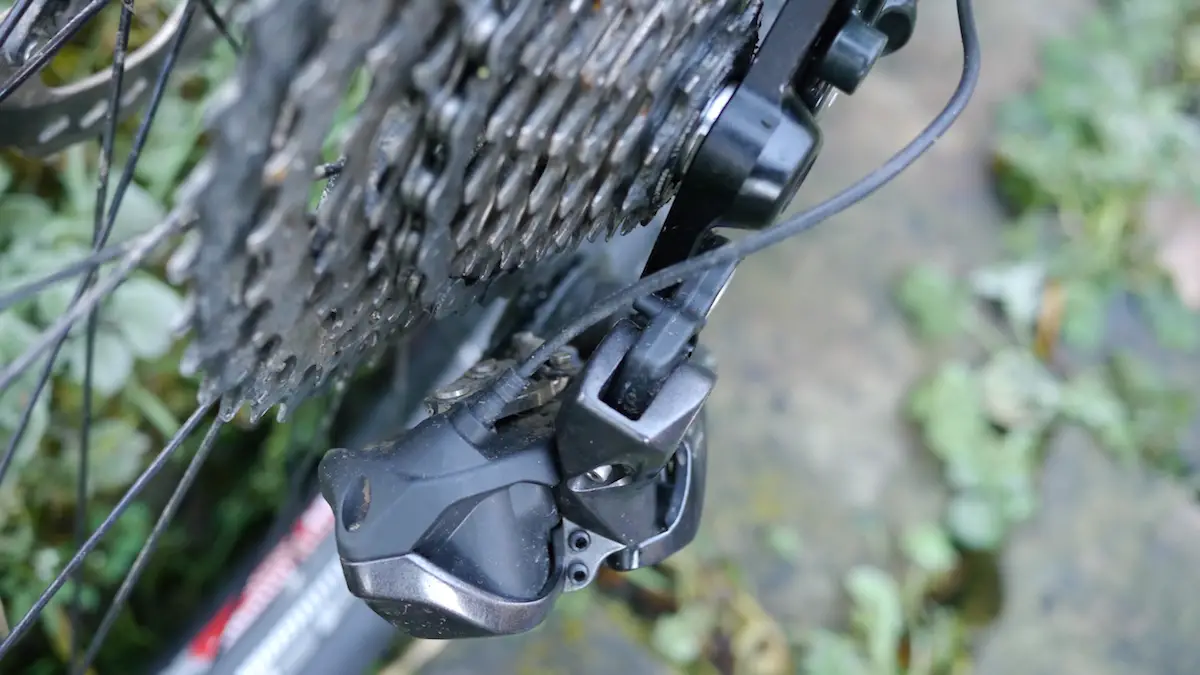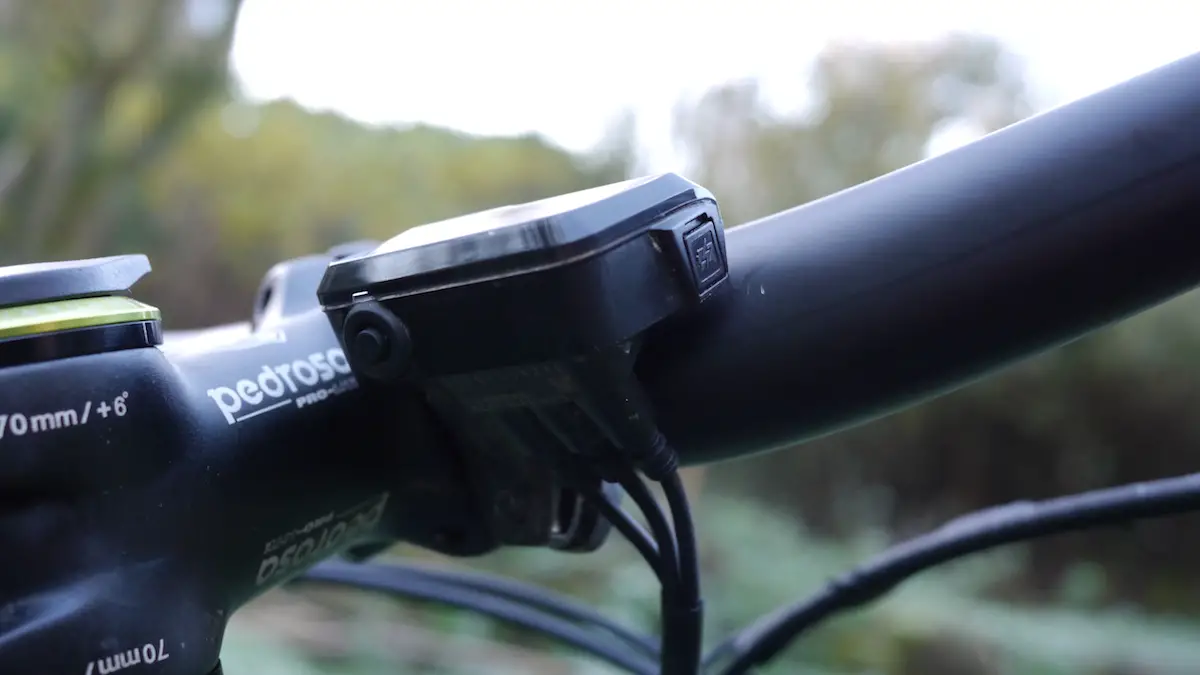To test both the durability and usability of the latest Deore XT Di2 drivetrain from Shimano, we gave a groupset to our local gear-thrasher and tech-lover, David Hayward. Six months later, and he’s ready to hand down his assessment.
“Bzz! Bzz! Bzz!” goes the rear mech as I click the shifter, and somewhere within me a 13-year-old self is screaming “CYBER”. If the film Hackers had involved bikes instead of rollerblades, this is what they’d have been excited about instead of some silly Gibson supercomputer. If you want a mountain bike drivetrain that makes cool robot noises, this is definitely for you. There’s more to it than that though.

Physical Installation
While it initially looks complicated, installing XT Di2 is actually a breeze. The wiring comes in preset lengths with sealed plugs on the ends, and the LCD display unit has three cable ports to take connections from the battery, mechs, and shifters. If you need to connect multiple mechs or shifters, there are optional cable junctions to allow this.
There’s a little plastic pushy tool for inserting the connectors, ensuring they’re all the way in and waterproof, and also to prevent strain on the cables as they’re pushed home. If the wiring initially looks complicated, it quickly becomes clear that it’s not. It goes together like some kind of extremely sensible LEGO for grown ups, and you can then neaten it up with heatshrink, zip ties, or electrical tape.
Latest Singletrack Merch
Buying and wearing our sustainable merch is another great way to support Singletrack

We built this 2×11 drivetrain up with a double crankset and front mech, but only one shifter. The prices are listed accordingly, so you’ll need to factor in purchasing the other bits (chain, cassette, cranks & BB), if you’re starting from scratch. Weights for the Di2 components tested are as follows; front mech: 150g, rear mech: 329g, battery: 50g, shifter: 93g, and display: 30g.
Once everything was connected and charged, the components all recognised each other and immediately worked together, save for a little tweaking. So far, so great, and really no more complicated than installing and routing a cabled drivetrain.
Setup
As well as having a charging/data port the display has a single button. Along with the shifter paddles, that’s used to control or alter certain things such as derailleur trim, or choosing one of two different shifting modes.

The key-presses can be difficult to remember, and the small LCD doesn’t have space for verbose clues. One tester who borrowed the bike reported the front derailleur had stopped working, but it turned out someone had just put it into a different mode without realising. The mech was fine.
While it has a certain degree of auto-trim, the front mech might also require adjustment of the limit screws, but unfortunately they don’t quite map to your existing knowledge of front mech screws, and there’s a lock screw to undo before adjusting them. Not a showstopper, and they probably had to design it this way around the servo-motor, but it would be better design to build on prior knowledge and affordances (the rear mech limit screws are much like any other rear mech though).
The two default gear maps for a single shifter were a little bit odd, with either large ratio gaps, or front mech shifts where I didn’t want them. I wanted to change it, which brings us on to software.

The Software
If you don’t want to read some nerdy stuff about computers, skip to the last paragraph of this section. Let me save you some or all of three headaches, because at the time of testing, Shimano’s software and documentation weren’t designed to:
- The iOS or Android app requires you to change the initial Bluetooth passcode after pairing. To ever connect again, this means you’ll have to go into your phone/tablet settings, delete the pairing profile you made the first time, then pair with the drivetrain a second time using the new passcode.
- E-Tube is only compatible with Bluetooth LE (Low Energy), which is only in more recent device chipsets. The App Store and Google Play can automatically check this and, before installation, inform the user if the app cannot work with the device. Shimano has not implemented this. Instead, the app will install, open, then just not work properly.
- The PC software (there’s no Mac software) specifically requires Microsoft .NET 3.5 SP1, which is around a decade old, superseded, and takes some spelunking to find.
Suffice to say over several weeks I fruitlessly downloaded gigabytes of data on rural internet, ran out of devices to try, and walked away several times. The only thing that worked reliably was carrying the bike through the house to the sole Windows computer we have then connecting it with the charger. Well, that, and buying a brand new 2017 phone. Once it’s (finally!) installed and connected, the PC software has almost endless progress bars. It also complains if you start it without internet.

Remapping gears is easy once you’re (finally!) there. I discover another quirk: if you physically disconnect the bike without shutting the software down, your drivetrain is dead until you reconnect it to the PC. It didn’t catch me out, but if it hasn’t already, for someone one day, this ungraceful failure mode will completely ruin the ride, race or holiday at the other end of a car journey. The software feels like it was made by and for engineers. It’s filled with annoying gotchas and pauses, but hopefully some of the inevitable upcoming progress bars will fix that.
I remapped the shifting to work like a very wide range 1x setup, and was relieved to never need the software again. If you’ve skipped ahead to this paragraph, and later find you’ve bought XT Di2 and are having a load of trouble, come back and read this entire section.

The Ride
As mentioned, the gears were mapped to work with a single right hand shifter. Physically, the shifter takes a bit of getting used to, as the paddles on it are different to any other cabled shifter Shimano has made. At first I was occasionally confused by the shape of them, but quickly got used to it. Of note is that the shift action can be flipped – you can assign the upshift to either of the two paddles, depending on what works for you. In addition to this, a small allen key will allow you to move the paddle’s lateral position by about 10mm.
The click is very affirmative compared to Shimano’s Di2 road/CX shifters. While the XT Di2 click does feel easier than the pull and click of a cable shifter, it’s still meaty enough for you to definitely feel it through a glove. One drawback for some users will be that pushing the upper shift paddle with finger rather than thumb is gone. In a 2015 poll of 529 Singletrack readers, 21% only ever used their finger with the upper paddle on Shimano shifters, 21% usually used their finger, and 29% sometimes did. Only 25% never did or didn’t realise they could.
One thing Di2 can do that other shifters can’t is continuously shift up or down the cassette for as long as you’re pedalling and the paddle is held down. This is pretty magnificent, made me a little lazy and occasionally ruined me for the first few shifts on non-Di2 equipped bikes. If you don’t pedal while shifting, the mech will make some slight noises of complaint, but has some clever things built in so it won’t mash anything to pieces. This also includes a crash mode designed to prevent damage to whatever extent it can, though in this case never put to the test.
The front mech rubbed occasionally, and both manual and auto trim never quite solved it. It was only light rubbing at extremes of the cassette, and never became a severe problem.

The display emits a single beep one shift before it’s going to move the front mech, which is a great bit of usability design. It also beeps twice to tell you when you’re at either extreme of your gear range.
I try not to run double cranksets nowadays, with 32-42 1x drivetrains sufficing for nearly all the riding I do, and it seems most riders I meet are in the same ballpark too. That said, I was occasionally grateful for the increased gear range. Between the double and the cassette, this drivetrain ranged from 34-11 to 24-42 (540% total gear range). Normally I do short, intense rides that don’t require such a wide range, but by the fatigued end of a fifty-mile loop it came in extremely useful for the last hills. Not only could I still winch my carcass up them, but having it work like 1x meant I could spend more of my limited remaining concentration on the trail. Likewise, for undulating cross-country trails winding through woods and quarries, it excelled in ways a standard double can’t. Set it up right and you always have an appropriate gear next, never ending up in that awkward overlap zone where you constantly have to think about front shifts.

One thing I had confidence in from the start was the weatherproofing – I’ve seen Di2 equipped bikes go up to the headset in water and just keep working. For this reason, Di2 is a popular choice for cyclocross racers. This test drivetrain lasted though all weathers and long rides, including another Singletrack reviewer borrowing it for the Dyfi Enduro. Over six months and hundreds of miles of riding, we only charged the battery twice, the gears never needed re-indexing, and they stayed mechanically reliable.
Overall
XT Di2 is a heftily priced upgrade on top of an XT cassette, crankset, and chain. That said, it is a solid and reliable drivetrain that, even a few years after trying out XTR Di2, feels like it’s from the future. The current software is disappointing, but once the drivetrain’s tuned to your preferences it’ll just work.





I can just about see the point if you insist on a double but at that price if you run a 1x, I don’t really get it, short of gadgetery for gadgetry’s sake.
Shimano should focus on making a proper/modern XT groupset first. It’s like putting torque vectoring on a horse and cart.
With buggerd thumbs my new bike will be di2 1×11 with a button next to each grip for up one side and down the other
Normally I use grip shift but modern disc brake Levers don’t work so well with bulk twist shifters
The E-TUBE sure is poor but gets there in the end